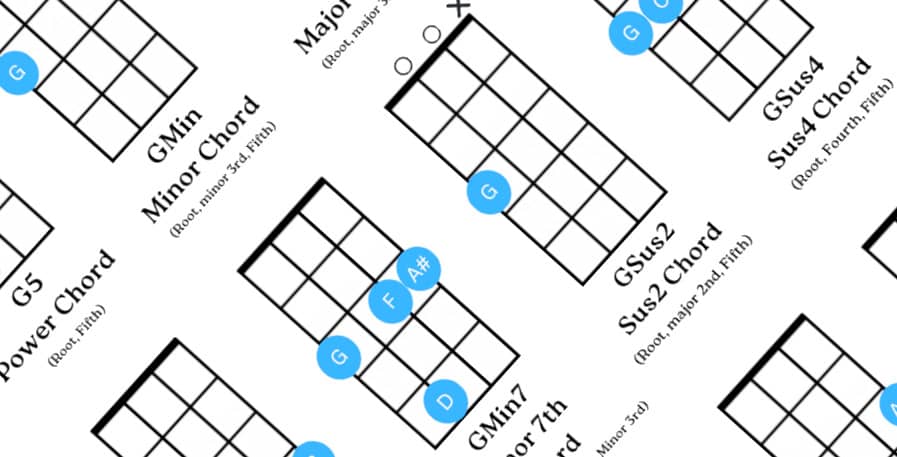When I got my first bass 16 years ago, I remember feeling overwhelmed by trying to learn chords.
I didn`t know how to make use of the chords I memorized or what all the different names of them meant. Thus, even though I could look up what different chords looked like, I was slow to progress.
Nowadays, I know how to make good use of bass chords both when improvising and composing. However, I don`t want any aspiring bassists to go through the same unnecessary hardships I did to get here. That`s why I have made this easy-to-use bass chord chart, with an accompanying guide.
I`ll start by explaining how to read the chart and how to play any bass chord in any key. I`ll also show you what the names of the chords mean, and in what contexts they can be used. Lastly, I`ll also cover slash chords and the two main ways to play chords on the bass.
Chord Chart
First things first, here is the bass chord chart I promised you. I will explain how to use it below, so don`t worry if some parts of it seem overwhelming at first.
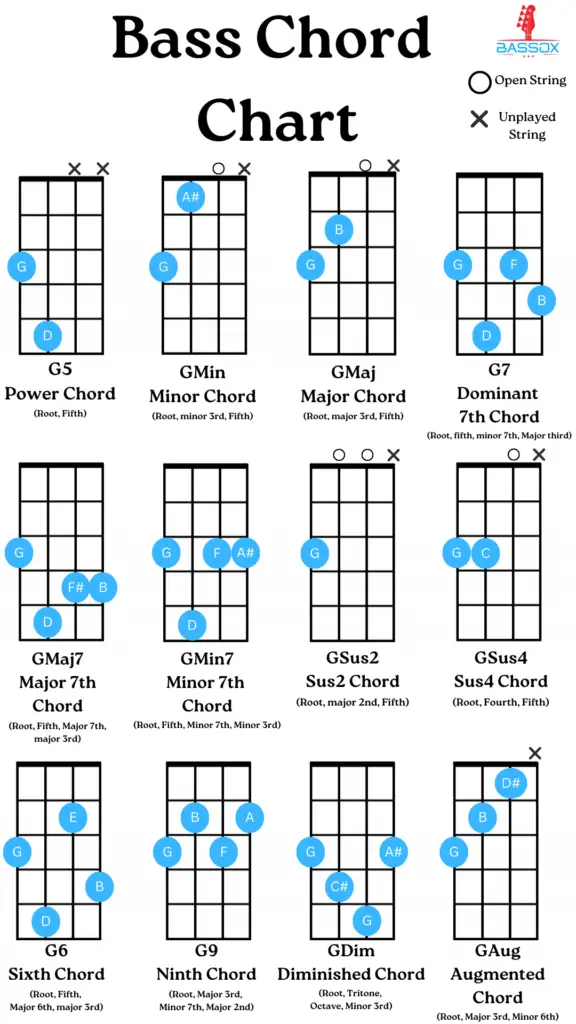
The leftmost string on the images is the thick E string of the bass, while the rightmost is the thin G string. The blue circle represents where to place your finger, and what note is found on that fret. Open strings are indicated with an “O” above them, and unplayed strings have an “X”.
The first line of text is the name of the chord. The second line tells you what type of chord it is. Lastly, the third line consists of what intervals make up the chord. If you are unfamiliar with music theory, you can disregard the last line for the moment.
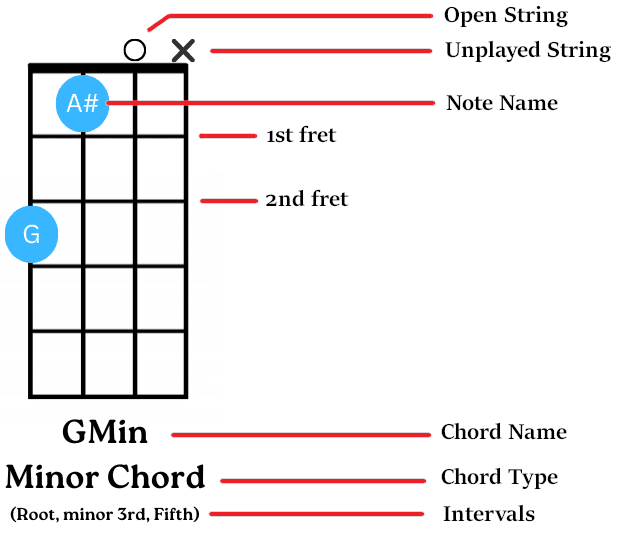
The main way to use the chart is for learning and memorizing where to place your fingers to play the chord. This finger pattern will remain the same despite what key you play the chords in. This is what makes the chart helpful as a cheat sheet, as you will now learn how to use it to play any chord in any key.
In my guide on beginner bass chords, I go more in-depth on how to play the easiest of the chords in the chart. It also includes tabs, notes, sound, and examples of bass lines that make use of the chords.
Changing the key of bass chords
For simplicity, all of the chords in the chart above are in the key of G. Naturally, every single chord can also be played in different keys.
For example, F is a key that is 1 whole step deeper than G. This means that to play a chord in F instead of G, it needs to be played 2 frets deeper. The position changes, but the finger pattern remains the same.
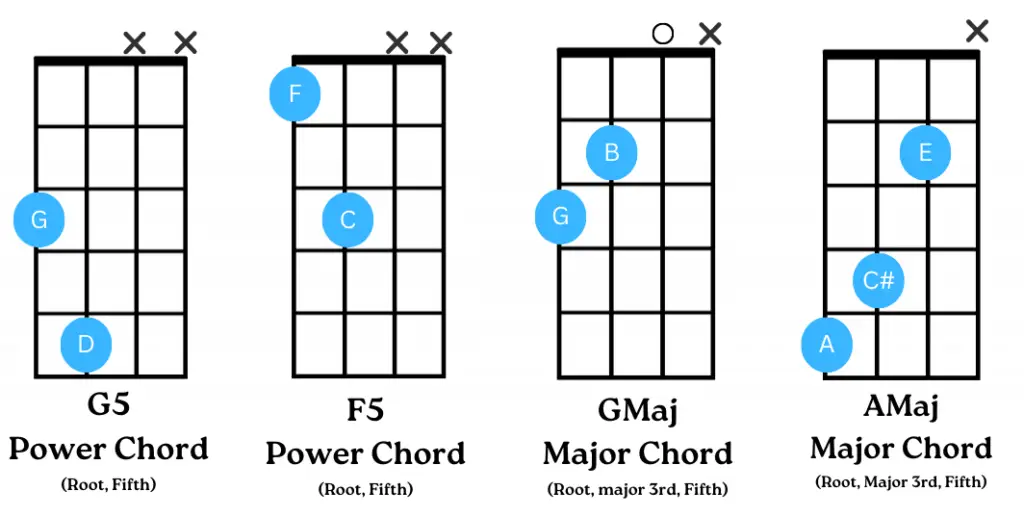
In some cases, the range of the bass will limit what types of chords you can play. For example, we cannot move the GMaj in the example above down to a Fmaj. This is because we don`t have enough deep strings to play a low F together with a low A and a low C on 4-string bass in standard tuning.
This can be solved by playing a higher A. However, this changes the voicing of the chord and requires you to learn a new finger pattern. Thus, what you can do instead, is to play the chord an octave higher up on the fretboard.
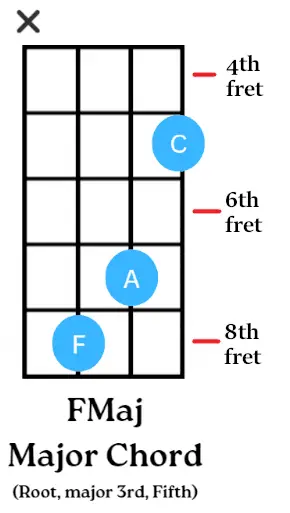
This way, you can always make use of the finger patterns in the chart above. You just need to adjust where on the neck you play the chord in different keys.
At this stage, it helps a lot to know where to find the notes on the neck of the bass. For help with learning the fretboard, check out my Bass notes chart for an easy to use cheat-sheet.
For 5-string players: I have also made a 5-String bass notes chart.
Slash Chords
All of the above examples use the chord’s root note as its deepest note. The root note is the core note that the rest of the chord is constructed out of. The root note of a G7 is a G, and The root note of an Asus4 is A.
The deepest note of a chord sets the feel of a chord. Using the root note of the chord as its deepest note is common and makes for a stable and harmonious sound.
However, this does not mean that all chords use the chord’s root note as the lowest note. Other chord notes are sometimes used instead to give the chord a different feel while using all of the same notes. Chords of this kind are called slash chords.
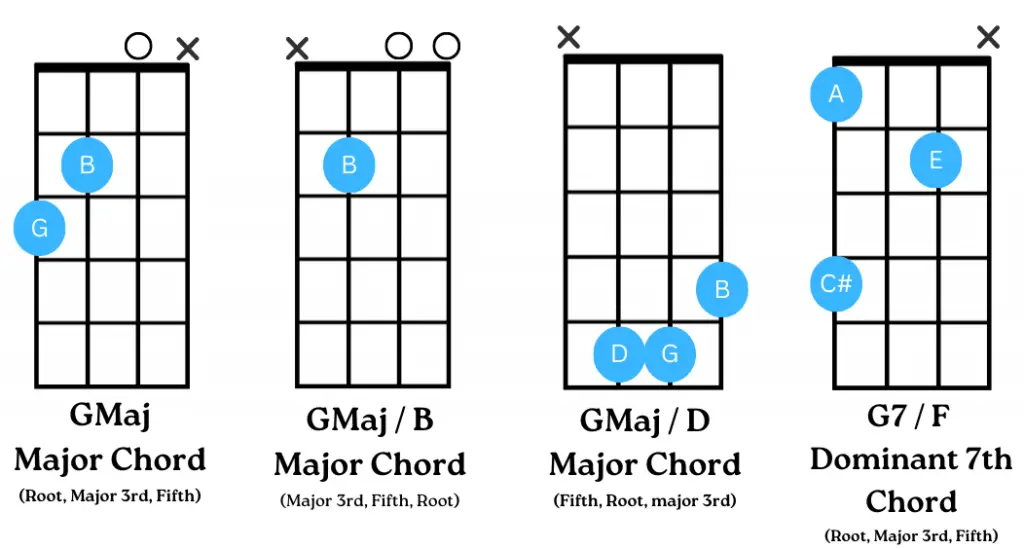
An example of a slash chord is GMaj / B. Here, “GMaj” is the name of the chord, whereas the “B” tells us to use the “B” as the lowest note of the chord.
Using the 3rd or 5th as the lowest note of the chord are common ways to play slash chords. I like to think of the root not as vanilla, and the 3rd and 5th as chocolate and strawberry. Not as basic, but still digestible and flavourful for most people.
The 7th is also used in slash chords, especially in jazz. However, this changes the feel of the chord more noticeably. It is more like licorice; amazing to some but less appealing to others.
It`s possible to use other chord notes as the root note, but this is less common. Thus, when experimenting with slash chords, I recommend starting with the 3rd and 5th. Jazz, blues, and soul bassists might also find it worthwhile to experiment with 7ths.
Bass chord names explained
Here is another infographic. This one explains what different bass chords sound like, and how they get their names.
Ivè tried to avoid theory and talk of scales as much as possible to keep it accessible to everyone. However, as the name of most chords is related to scales, this can`t always be avoided.
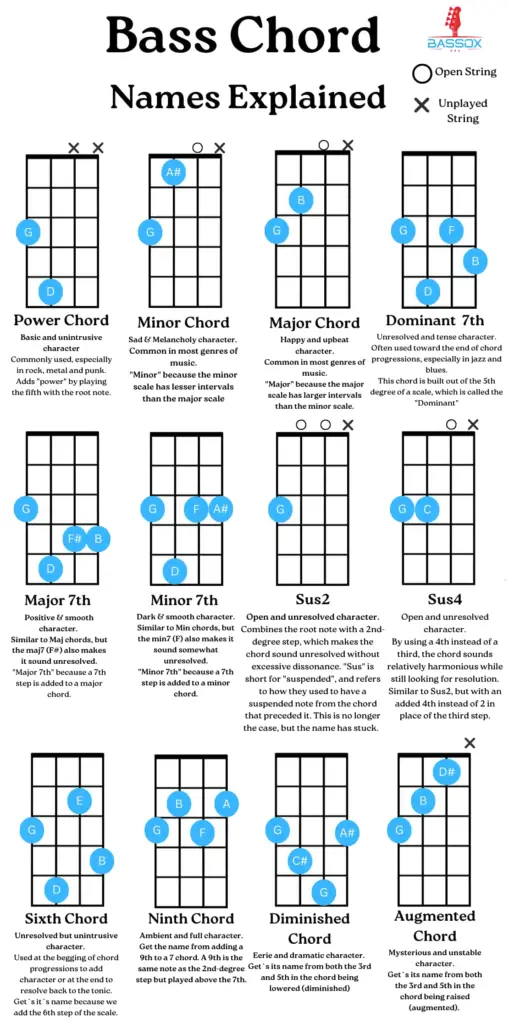
For most genres, you can get far with just the power, major, and minor chord. In many genres, most songs are constructed entirely out of these.
However, jazz, blues, soul, and hip-hop bassists often use various 7th chords in their bass lines. Thus, you might want to put extra emphasis on learning these chords if you enjoy these genres. To learn more, check out my article on jazz bass scales to learn how to make use of them.
For genres like rock, pop, metal, and punk, 7th chords are still useful. However, they are much less of an essential part of your tool kit. Learning all these chords will elevate your bass playing, but mastering the three first chords will get you well on your way.
Strumming Bass Chords
There are two main ways to play chords on the bass.
The first is to strum the bass chords. This means that you play every note of the chord at once.
This is the less common way to play chords on the bass guitar. Yet, it is often what people have in mind when they talk about playing chords.
The main challenge of strumming is that bass chords can sound muddy. To understand what I mean here is an example of what a deep bass chord progression can sound like:
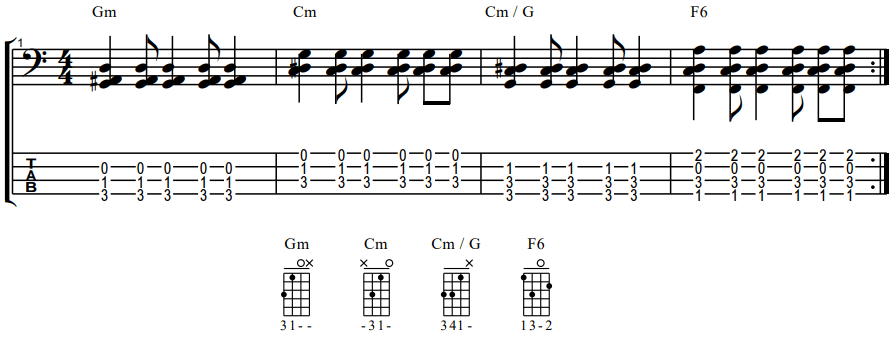
Due to the boomy and unclear sound chords can have, many bassists elect to never strum chords. However, there are ways to get around this.
One way to make the chords less unclear is to use chords that consist of a few notes. This makes power chords on bass a potent option that sees a good bit of use in genres like punk-rock.
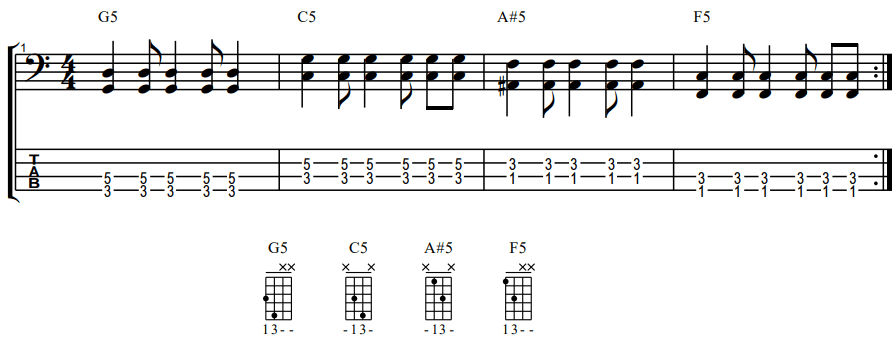
Another option is to play chords high up on the bass. At a higher pitch, they will not sound as muddy, which makes strumming them sound more pleasant.
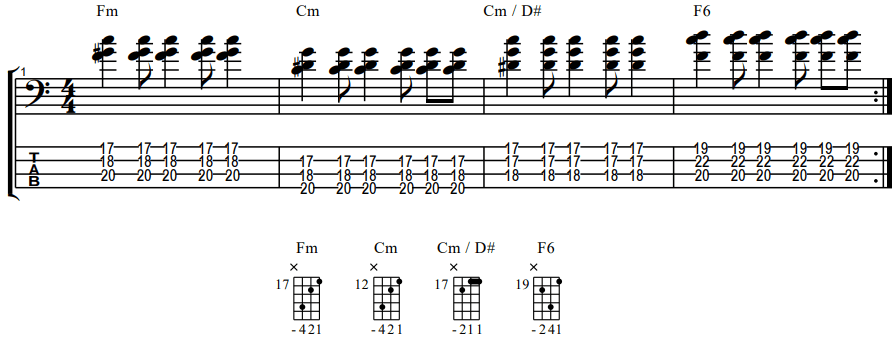
Plucking Bass Chords
The other option is to play the notes of a chord one note at a time. I`ve seen this lead to some confusion from time to time, as most people associate playing chords with strumming. However, bass players do in fact play chords, they usually just don`t play every note of it at a time.
This solves the abovementioned issue of sounding muddy. It is also what allows bass lines to sound groovy, funky, and locked in with the drums. To illustrate this, let`s listen to a similar bass line as in the example above, but played one note at a time.

Groovier and clearer. Thus, it is oftentimes preferable to stick to playing the bass in this style. Strumming chords is great, but it is more demanding to pull off well.
This is one of the key differences between bass and guitar. Guitars are usually strummed, whereas basses are usually not. However, knowing what notes make up a chord is an essential skill for both instruments.
Thus, exploring what type of patterns you can come up with based on the notes of the chords in the chart is a great practice exercise. This will develop your understanding of the fretboard, improve your ability to compose, and most importantly allows you to get creative.
Conclusion
Memorizing the finger pattern for each bass chord will take some practice. If you are unfamiliar with where to find the various notes on the neck of the bass, this is also a skill that will need to be developed.
However, once you have these basics down, you will be well on your way to making good use of chords in your playing.
While it`s been many many years since this first clicked for me, I still remember vividly how this improved my bass playing.
Thus, I hope that the above information can serve you well in achieving the same feeling.
Using and getting creative with chords is also a valuable skill that can be developed forever regardless of what genre you play. I can tell you this from experience, and with that also guarantee that it is a skill you won`t regret learning.

